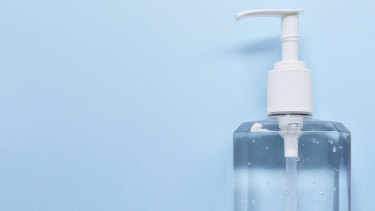As supplies of hand sanitiser run out around the country, people desperate to get their hands on coronavirus-killing substances are looking to the internet for homemade sanitiser recipes.
Many of the recipes circulating online include mixing ingredients such as alcohol and aloe vera. And while it may be a clever idea in theory to go DIY when the commercial products are sold-out, experts are warning against it.
Health experts are warning against DIY hand sanitiser.Credit:iStock
The problem, they say, is the proportions are hard to get right for an effective concoction, making it can be a fire hazard and the mixture can get contaminated with bacteria, even becoming harmful.
“I have a real problem with alcohol-made handrubs and these recipes,” says UNSW infection control expert Professor Mary-Louise McLaws.
“You're assuming that the recipe you access is going to protect you form COVID-19, but getting the right proportions of alcohol and ingredients is really an exact science.
“The solution needs just the right amount of isopropyl and ethanol (both 65 per cent plus). If the percentage of alcohol in the solution is anything below that number, it will stop working as a disinfectant, and if it's anything above, it will need longer exposure time on your hands to work.”
Monash University infectious diseases expert Professor Allen Cheng agrees.
“It isn't necessary [to make your own hand sanitiser]. Soap and water is fine at deactivating coronaviruses,” he says.
He says even using a World Health Organisation-approved recipe would be a bad move.
“It involves pure alcohol and would be at the very least a fire hazard, and at the worst could easily get contaminated with bacteria and be harmful,” he says.
According to the WHO, there are two formulations for making sanitiser, and both require not easily accessible ingredients difficult – and a certain amount of skill to make.
“The WHO recipe is directed at healthcare workers and hospitals in low resourced settings,” Professor McLaws says.
The bottom line, Professor McLaws says, is don't bother trying any recipe.
“To have a hand sanitiser that works both as an anti-bacterial and an anti-viral agent, you need the right mix of isopropyl alcohol (or isopropanol) and ethanol, as well as other ingredients that mask the smell and prevent the alcohol from drying out the hands," she says.
“Trying to get the correct level of isopropyl alcohol and ethanol is potentially a fire risk.”
So what should you do if you’re unable to access hand sanitiser or immediately wash your hands?
“Don't touch your face, identify a “safe space” to get to (work, home etc) where you can disinfect your hands,” Professor Cheng says.
In most cases, tap water and regular household soap will do, excluding medicated soaps which often contain antibacterial agents.
“You do not need a medicated soap, which was only developed to give the patient in a hospital additional time to be risk-free of pathogens (dangerous germs) on healthcare workers’ hands,” Professor McLaws says.
“We shouldn’t aim to kill all the germs on our hands; many germs are normal and keep the skin healthy, and we want them to come back.”
“Soap and water act as an emulsifier by removing all the good germs – but not killing them – as well as the dangerous germs which are usually hitchhiking a ride on our hands”.
So when you can't buy alcohol-based hand rubs from stores, don't sweat it. Stick to doing a proper soap-and-water wash, Professor McLaws says. Simply follow the below steps.
Source: Read Full Article

